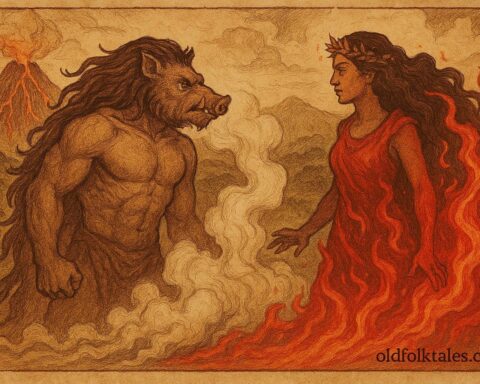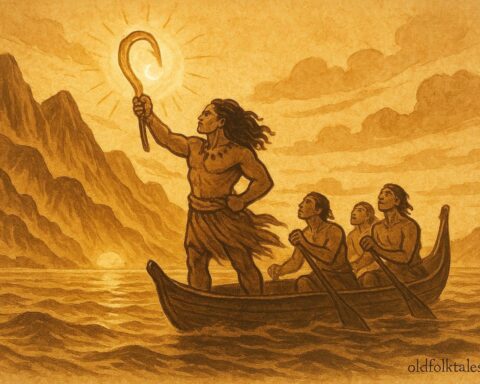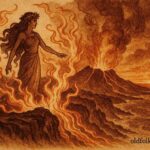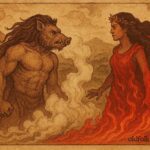In the rugged heart of Aotearoa, where the mountains rise from the mists and rivers carve deep paths through ancient lands, there lived a powerful and cunning chief named Te Rauparaha. He was the leader of the Ngāti Toa tribe, bold, ambitious, and unyielding in his quest to lead his people to strength and safety during an age of intertribal conflict.
Te Rauparaha was known for his strategic brilliance and fearless spirit. Yet his greatness earned him many enemies among rival tribes, particularly those of the Ngāti Te Aho and Ngāti Raukawa, who feared his growing power. Their jealousy and mistrust ignited a series of battles that forced Te Rauparaha and his followers to wander from region to region in search of refuge and alliance.
Explore tales of ancestral spirits and island creation that connect people to the land and sea
The Pursuit
One fateful day, Te Rauparaha found himself pursued by a band of hostile warriors. They had tracked him across rivers and valleys, their shouts echoing through the hills. His followers were scattered, his weapons few, and his body weary from days of flight. The great chief, who had once stood at the head of an army, was now alone, hunted, and desperate.
He reached the lands of the Ngāti Raukawa tribe, uncertain whether they would aid or betray him. Every step he took through their territory carried the weight of danger, for alliances were fragile and often changed with the tides of war. Yet Te Rauparaha had no choice. He needed sanctuary, or death would surely find him before dawn.
In the distance, the cries of his pursuers grew louder. The forest trembled with their approach. The air felt thick with fate.
The Hidden Pit
At last, Te Rauparaha came upon a small settlement belonging to Te Wharerangi, a chief of Ngāti Raukawa. Though unsure of his intentions, Te Rauparaha approached him with the humility of a man seeking protection under ancient Māori custom. “Friend,” he pleaded, “your enemies pursue me, but I come not as an invader. I come as a man in need. Grant me shelter, and I will forever remember your kindness.”
Te Wharerangi was moved. Though the politics between tribes were complex, Māori law held deep respect for the sacred act of offering protection. Turning to his wife, Te Rangikoaea, a woman of wisdom and mana (spiritual authority), he said, “What shall we do for this man who flees from death?”
Te Rangikoaea answered without hesitation: “Hide him beneath our pātaka kai,the food storehouse. There, among the offerings of the earth, no one will think to look.”
Beneath the raised platform was a deep pit, dug long ago to store kūmara (sweet potatoes) and roots. It was dark, damp, and filled with the scent of soil and wood. Te Rauparaha climbed inside without protest. As Te Wharerangi replaced the cover, sealing the entrance, the hunted chief found himself swallowed by shadow.
Above him, Te Rangikoaea knelt and whispered a quiet karakia (prayer) to ward off the spirits of death and betrayal.
“Ka Mate! Ka Mate!”
Moments later, the pursuers arrived. The sound of their footsteps thundered through the village as they demanded to know where Te Rauparaha was hiding. “He has passed through here!” they cried. “Show us the path!”
Te Wharerangi remained calm. “I have not seen him,” he said, truth shimmering in his voice like a blade’s edge. The pursuers searched, but the pit beneath the pātaka kai escaped their notice. The gods of the earth, it seemed, shielded Te Rauparaha that day.
In the darkness below, Te Rauparaha could hear everything, the stamping of feet, the angry voices, the silence that followed. His heart pounded like the rhythm of a drum. Death was so near he could taste it in the air.
He whispered to himself, “Ka mate! Ka mate!”, “I die! I die!” The words rose from the pit like breath itself, trembling with fear and defiance.
Then, as the voices faded and silence returned, a ray of light pierced the darkness. Te Wharerangi lifted the cover and called out softly, “E Te Rauparaha, the danger has passed.”
Te Rauparaha climbed from the earth, his body shaking with relief and his spirit surging with life renewed. Looking to the heavens, he cried out with joy and awe:
“Ka mate! Ka mate! Ka ora! Ka ora!
Tēnei te tangata pūhuruhuru,
Nāna nei i tiki mai whakawhiti te rā!
Upane! Ka upane! Upane! Kaupane!
Whiti te rā!”
“I die! I die! I live! I live!
Behold, the hairy man
Who has brought the sun to shine again!
Step upward! Another step upward!
One last step! Into the sunlight!”
His words, born from fear and triumph, became an immortal chant, the Haka ‘Ka Mate’. It was not a song of war, but of life prevailing over death, courage over despair, and faith in the strength of one’s ancestors.
Legacy of the Chant
Te Rauparaha survived that day and went on to lead the Ngāti Toa tribe to new lands in the south, establishing their legacy across Aotearoa. The haka he composed in that pit became the symbol of Māori endurance and mana. Generations later, it would be performed by warriors before battle, by tribes during ceremonies, and by New Zealanders across the world as a proud emblem of identity.
Whenever “Ka Mate” is performed, the spirit of Te Rauparaha lives again, the chief who faced death in darkness and rose to the light.
Moral Lesson
True courage is not found in strength alone, but in the will to rise again after fear and despair. Te Rauparaha’s chant teaches that life’s triumph often begins in the shadows, where faith, gratitude, and the help of others guide us back to the light.
Knowledge Check
- Who was Te Rauparaha?
He was the chief of the Ngāti Toa tribe, known for his bravery, leadership, and creation of the haka “Ka Mate.” - What event inspired Te Rauparaha to compose the haka “Ka Mate”?
His near escape from enemies while hiding in a food pit beneath a friendly chief’s hut. - What does the phrase “Ka mate! Ka mate! Ka ora! Ka ora!” mean?
It means “I die! I die! I live! I live!”, a cry of fear turned to triumph. - What cultural values are reflected in this folktale?
Bravery, survival, respect for hospitality, and gratitude for divine protection. - Why is Te Wharerangi’s and Te Rangikoaea’s role significant?
Their compassion and adherence to Māori law of protection preserved the life of Te Rauparaha, allowing his legacy to endure. - How does the haka “Ka Mate” represent Māori cultural identity today?
It symbolizes resilience, unity, and the enduring power of Māori tradition and pride.
Source: Adapted from “The Story of the Ka Mate Haka” in Nga Moteatea: The Songs, collected by Sir Āpirana Ngata (1928).
Cultural Origin: Māori (Ngāti Toa tribe, Aotearoa/New Zealand)












